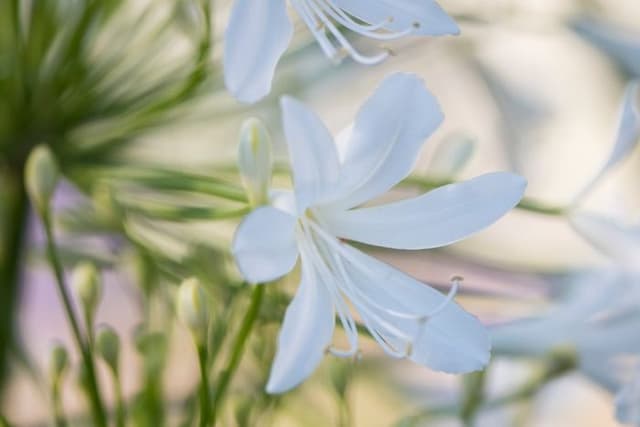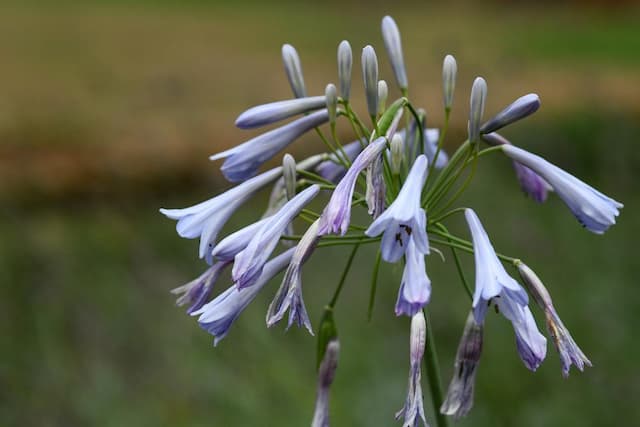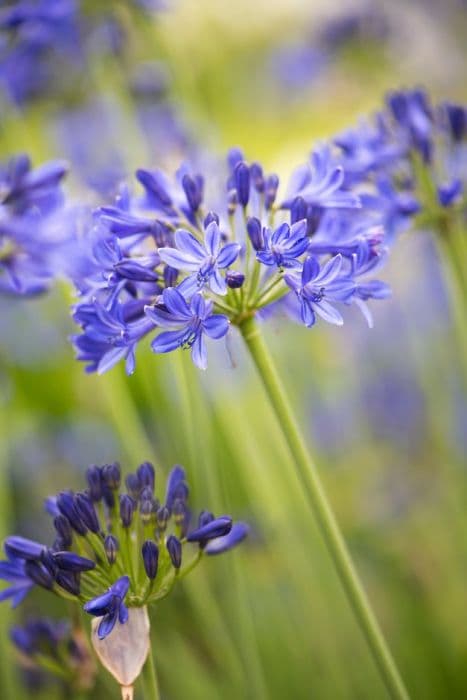Lily of the Nile Agapanthus 'Lilliput'

ABOUT
The Agapanthus 'Lilliput', commonly known as the Dwarf Lily of the Nile, is a perennial plant known for its compact and tidy form. It showcases lush, strap-like green leaves that gracefully arch outwards, forming a dense clump. From the center of this verdant foliage emerges a stout and upright flower stalk, which is topped by a rounded cluster of trumpet-shaped flowers. The blossoms are a striking shade of blue or violet, giving a vivid pop of color when in bloom. Each individual flower is petite and funnel-like, contributing to the overall globe-like structure of the floral cluster. The texture of the leaves is somewhat fleshy, indicating the plant's succulent nature, which aids in drought resistance. The Dwarf Lily of the Nile's appearance is further characterized by its neat growth habit, making it a popular ornamental choice for gardens and borders.
About this plant
 Names
NamesFamily
Amaryllidaceae
Synonyms
Lily of the Nile, African Lily, Dwarf African Lily
Common names
Agapanthus 'Lilliput'
 Toxicity
ToxicityTo humans
The Lily of the Nile, despite its striking appearance, is toxic to humans if ingested. All parts of the plant contain substances that can cause symptoms such as nausea, vomiting, and diarrhea. In severe cases, ingesting parts of the Lily of the Nile can also lead to dizziness and abdominal pain. It is particularly important to keep children away from the plant as they are more susceptible to the toxic effects.
To pets
The Lily of the Nile is also toxic to pets. If a pet ingests any part of this plant, they could experience vomiting, nausea, and diarrhea. Depending on the amount ingested, they might also display symptoms such as lethargy or drooling. It is imperative to prevent pets from chewing on any part of the Lily of the Nile, as the toxic components can be harmful, and in severe cases, could lead to more serious health issues.
 Characteristics
CharacteristicsLife cycle
Perennials
Foliage type
Evergreen
Color of leaves
Green
Flower color
Blue
Height
1-2 feet (30-60 cm)
Spread
1-2 feet (30-60 cm)
Plant type
Bulb
Hardiness zones
6
Native area
South Africa
Benefits
 General Benefits
General Benefits- Easy to maintain: Agapanthus 'Lilliput' is known for its low maintenance requirements, making it perfect for gardeners of all skill levels.
- Drought-tolerant: Once established, this variety of African Lily is quite tolerant of drought, reducing the need for frequent watering.
- Long blooming period: It produces long-lasting blooms throughout the summer, providing a consistent display of color in the garden.
- Compact size: Being a dwarf variety, it is well-suited for small gardens, borders, and containers where space is limited.
- Attracts pollinators: The flowers attract bees, butterflies, and other pollinators, which are beneficial for the garden ecosystem.
- Landscape versatility: Its striking blue flowers and evergreen foliage offer a variety of landscaping uses, from borders to focal points.
- Frost hardy: It is relatively resistant to frost, making it suitable for a range of climates and extending its growing season in cooler regions.
 Medical Properties
Medical PropertiesThis plant is not used for medical purposes.
 Air-purifying Qualities
Air-purifying QualitiesThis plant is not specifically known for air purifying qualities.
 Other Uses
Other Uses- Photographic Subject: The Agapanthus 'Lilliput' with its globular clusters of flowers makes an excellent subject for both professional and amateur photographers looking to capture the beauty of nature.
- Artistic Inspiration: The striking form and color of the African Lily can inspire artists and be used as a motif in paintings, sculptures, and textile designs.
- Educational Tool: Botany teachers use the African Lily to demonstrate plant structure, flower anatomy, and pollination processes to students.
- Theme Gardens: African Lilies are ideal for creating a 'miniature' theme garden, making spaces appear larger with their small size and long-lasting blooms.
- Garden Borders: Due to their compact size, the Agapanthus 'Lilliput' can be used to define borders and edges in garden landscapes.
- Potpourri Ingredient: Dried African Lily flowers can add color and a light fragrance to homemade potpourris.
- Floral Arrangements: The smaller stature of the Agapanthus 'Lilliput' makes it suitable for intricate floral arrangements and table centerpieces.
- Wedding Decor: The elegant blooms can be used in wedding bouquets and venue decorations, particularly for events with a purple or blue color theme.
- Culinary Garnish: While not commonly used for their flavor, the petals of the African Lily can be used as a decorative garnish for culinary dishes.
- Fairy Gardens: The 'Lilliput' variety, being smaller in size, is perfect for inclusion in fairy garden designs, creating a whimsical and magical atmosphere.
Interesting Facts
 Feng Shui
Feng ShuiThe Agapanthus is not used in Feng Shui practice.
 Zodiac Sign Compitability
Zodiac Sign CompitabilityThe Agapanthus is not used in astrology practice.
 Plant Symbolism
Plant Symbolism- Love Letters: Agapanthus, also known as African Lily, is often associated with love and can symbolize love letters or messages.
- Enduring Love: The name "Agapanthus" is derived from Greek words meaning 'love flower', hence it is thought to represent enduring or everlasting love.
- Beauty: The striking appearance of the African Lily symbolizes beauty and attention to elegance.
- Fertility: With its lush foliage and rounded clusters of flowers, the plant can symbolize fertility and abundance.
- Freedom: Sometimes the African Lily is said to symbolize freedom due to the plant's growth pattern, where it fans out freely in all directions.
- Strength: The sturdy stems that support the rounded flower heads can represent strength and resilience.
- Home: Agapanthus, being native to South Africa, might be seen as a symbol of home and hearth for those from that region or who have an affinity with it.
 Water
WaterFor the Agapanthus 'Lilliput', commonly known as Dwarf Lily of the Nile, watering should be done thoroughly, ensuring the soil is evenly moist but not waterlogged. During the growing season in spring and summer, water the plant once a week with approximately one gallon of water per plant, adjusting for rainfall and temperature. Reduce watering in the fall and water sparingly in winter, allowing the soil to dry out somewhat between waterings. Always check the top inch of the soil; if it's dry, it's time to water. Avoid overhead watering to prevent disease, and aim to water early in the day to allow foliage to dry out.
 Light
LightThe Dwarf Lily of the Nile thrives in full sun to partial shade. The ideal spot for this plant is where it can receive at least six hours of direct sunlight daily. If grown indoors, a south-facing window is preferable. In extremely hot climates, some afternoon shade is beneficial to prevent scorching. Light is crucial for flowering, so ensure the plant has ample light to bloom robustly.
 Temperature
TemperatureDwarf Lily of the Nile prefers moderate temperatures and does best in conditions where the temperature is between 60°F and 80°F. It can survive minimum temperatures down to about 50°F and can tolerate heat up to about 90°F. For optimal growth, avoid exposure to temperatures below 50°F, as this may damage the plant.
 Pruning
PruningPruning Dwarf Lily of the Nile is necessary to remove spent flowers and to encourage the growth of new blooms. The best time to prune is after flowering has finished, usually in the late summer or fall. Cut back the flower stalks to the base, and remove any dead or diseased foliage. Pruning annually can help maintain the plant's shape and vigor, ensuring it comes back healthy and strong the following year.
 Cleaning
CleaningAs needed
 Soil
SoilAfrican Lily 'Lilliput' thrives in a soil mix that is well-draining, rich in organic matter, with a pH level ranging from 6.0 to 8.0. A suitable soil mix can be created by combining two parts loam, one part peat or compost, and one part sharp sand or perlite for increased drainage.
 Repotting
RepottingAfrican Lily 'Lilliput' typically needs repotting every 2 to 3 years to prevent it from becoming root-bound and to replenish its soil. Repotting is best done in the spring before the growing season begins.
 Humidity & Misting
Humidity & MistingAfrican Lily 'Lilliput' is not particularly humidity-sensitive but does best in moderate to high humidity conditions. Aim for a humidity level around 40-60% for optimal growth, but it will tolerate a range of humidity levels as long as the soil moisture is appropriate.
 Suitable locations
Suitable locationsIndoor
Place in bright, indirect light with good air circulation.
Outdoor
Full sun to partial shade, sheltered from strong winds.
Hardiness zone
8-11 USDA
 Life cycle
Life cycleThe Agapanthus 'Lilliput', commonly known as Dwarf Lily of the Nile, begins its life cycle as a seed, which germinates in moist soil conditions with warmth and adequate light. Once the seedling emerges, it grows into a young plant with strap-shaped leaves and a robust root system. The plant enters a vegetative stage where foliage grows and the root system expands in preparation for flowering. Upon reaching maturity, typically within a few years, Agapanthus 'Lilliput' produces tall stems topped with globular clusters of small, trumpet-shaped, blue or purple flowers in summer. After the flowering period, seeds form within the spent flower heads, which can be collected for propagation or left to self-seed if conditions allow. As a perennial, the Agapanthus 'Lilliput' dies back during the colder months and enters a period of dormancy, only to repeat its growth cycle when favorable conditions return in the spring.
 Propogation
PropogationPropogation time
Spring to early summer
The most popular method of propagating Agapanthus 'Lilliput', commonly known as Lily of the Nile, is through division. The ideal time to propagate by division is in the spring or early fall. To propagate, carefully lift the clump of the plant from the ground using a garden fork, being mindful not to damage the root system. Once the clump is out of the soil, you can gently tease apart the individual rhizomes, making sure that each division has at least one or two healthy growth points. These divisions can then be replanted into well-draining soil at the same depth they were growing previously, and spaced about 12 to 18 inches (approximately 30 to 45 centimeters) apart to allow for adequate growth. Water the new divisions thoroughly after planting to help establish the roots.







![African lily [Brilliant Blue]](/_next/image?url=https%3A%2F%2Fplants-admin.emdemapps.com%2Fimages%2Fplants%2F%2Fimages%2F604b5e3c28e2b.png&w=640&q=75)

